- A Study Of The Influence Of The Workplace Environment And Employee Motivation On The Performance Of The Organization
- Chapter 3: Methodology
- 3.1 Research philosophy
- 3.2 Research approach
- 3.3 Research design
- 3.4 Hypothesis development
- 3.5 Sampling and Populations
- 3.6 Data collection techniques
- 3.7 Data analysis process
- 3.8 Reliability and validity
- 3.9 Ethical considerations
- Chapter 4: Results and Findings
- Chapter 5: Discussion and Evaluation
- Chapter 6: Conclusion and Recommendations
- 6.1 Conclusion
- 6.2 Linking with objectives
- 6.3 Research Limitation
- 6.4 Recommendation
- 6.5 Future Scope
A Study Of The Influence Of The Workplace Environment And Employee Motivation On The Performance Of The Organization
Explore unparalleled assignment writing services in the UK with Native Assignment Help. Our commitment to quality and customer satisfaction sets us apart, making us the preferred choice for students seeking reliable assistance.
Chapter 3: Methodology
3.1 Research philosophy
Based on the research topic, the fundamental knowledge development is found to be based on research philosophy. There are 3 types of philosophies such as positivism, interpretivism and realism that researchers use as per research conveniences. Research philosophy refers to the beliefs of a researcher that gets engaged in the study in terms of different phenomena (Žukauskas et al. 2018). Engaging positivism philosophy has helped the researcher in this study to meet the goal of the social world from different operative dynamics. As this study has been processed with primary quantitative aspect, positivism philosophy has helped in evaluating data in a systematic manner. Research philosophy must be selected in an appropriate way or the adherence of the study might get decreased. The positivist one has helped this study in exploring the factual knowledge about the work environment and employee motivation as those can influence organizational performances.
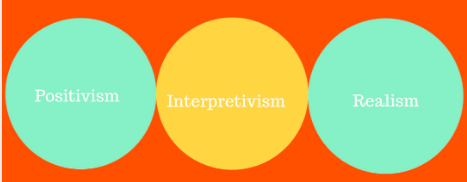
Figure 3.1: Research philosophy
In comparison to the other two types of research philosophies, the positivism one has observed the accurate need of the study objectives and hence, moved accordingly. As the researcher has limited the study interpretation by allowing to get only 100 participants’ opinions, measurement and evaluation have been done with higher degree of trustworthiness. This specific philosophy has made the study testable and concurred with a single hypothetical view in terms of reaching to a conclusive knowledge. The chosen philosophical ideology has excluded all kinds of metaphysical speculations by prioritizing the research relevance subject matters.
3.2 Research approach
A research work is a long process that involves steps such as understanding research relevance, selection of resources, integrating data, analyzing those and getting conclusive knowledge. Research approach refers to the method that helps a researcher in choosing the right path for attaining the study aim and objectives with a clear sense (Woiceshyn and Daellenbach, 2018). Based on the qualitative and quantitative data accessibility, research approaches get selected. In this study while primary quantitative analysis has been followed solely, deductive approach is found beneficial. There are two more types of approach such as inductive and abductive that has been ignored in this subject matter and majorly focus went to the deductive one. Deductive approach helps a quantitative approach to generate hypotheses based on which an entire research paper gets conducted (Pandey, 2019). Besides, the deductive approach is also impactful in focusing on the topic-related materials by omitting the unnecessary elements due to their irrelevancy.

Figure 3.2: The path of deductive approach
It has been seen that organizational performance gets influenced due to several working measures while in this study only work environment and employee motivation have been prioritized. Therefore, the deductive one has helped in omitting the other elements away from the study and enhanced the value. Based on the study aim and objectives, the conclusion has been made with a clear and concise hypothetical perspective in which deductive approach is found to be the most efficient measure from any other methodological tool. Hence, it can be said that selecting the deductive one has resulted in the most appropriate way to explore the study sense.
3.3 Research design
Every individual researcher chooses a different way of integrating data and representing them towards the outer world. Research design helps in defining the overall strategy of the research work that meets research problems. In this study, an explanatory research design has been obtained as the researcher has explained the opinions of participants by aligning with the research requirements. Research design is three types such as descriptive, explanatory and exploratory (Pathiranage et al. 2020). The researcher has not focused on explaining new concerns regarding the chosen topic but focused on describing the measures and how those are impacting the performance of Unza Vitalis Salatiga.
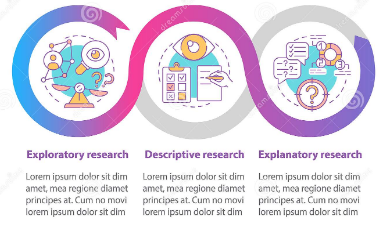
Figure 3.3: Research design
Besides, the study measures have not only been described but also explained with proper justification. It has given a clear understanding about the dependency of organizational performance over the identified two variables such as work environment and employee motivation. The changing nature of the workplace with the increasing work stress has affected the employee motivational factors that also have been explained in this study with the help of explanatory design.
3.4 Hypothesis development
Research variables define the characteristics of different values that are impactful in contributing a clear sense chosen topic. In this study, below-mentioned variables have been designed based on the dependency characteristics.
Dependent variables: Organizational performance
Independent variables: Work environment, Employee motivation
Based on the hypotheses, below-mentioned hypotheses have been developed that have helped in moving towards an accurate direction throughout the study.
H0: Work environment and employee motivation do not influence the organizational performance at Unza Vitalis Salatiga
H1: Work environment and employee motivation has a great influence upon the organizational performance at Unza Vitalis Salatiga
3.5 Sampling and Populations
In this study, a non-probability sampling process has been adopted for complementing the requirement of the chosen topic. There are basically two different types of sampling processes that integrate the academic field, one is probability and another one is non-probability based on the participants' characteristics selection (Robertson and Sibley, 2018). Prioritizing the sampling process helps in contributing equal value to each part of the research work in which participants and their opinions are found to be implemented. Both probability and nonprobability sampling techniques have their different subtypes from which this study has obtained the quota sampling one from the non-probability that helped out the researcher in choosing participants that have knowledge about work environment, employee motivational factors, and others.
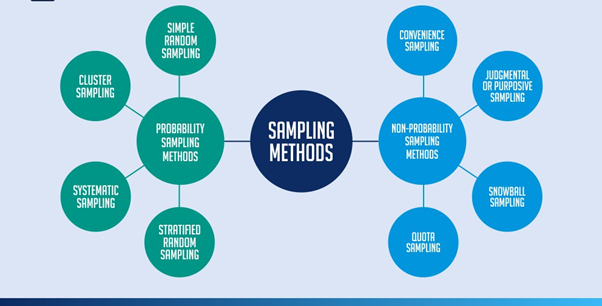
Figure 3.5: Sampling techniques
Research sampling and population selection play a vital role in increasing study value. Through the mentioned sampling process, 100 participants have been selected from the population group of the UK. It is obvious that there is a large number of people that are employed in different organizations from which this study has majorly focused on the employees of Unza Vitalis Salatiga to get core knowledge by narrowing down the study directions.
3.6 Data collection techniques
In this study, the data has been collected from primary resources and therefore, participants have been found to engage. Data collection process is mainly of two types such as primary and secondary. Those can help in gathering data and interpreting research relevance based on study requirements (Runco and Beghetto, 2019). Primary research denotes the one where a researcher can collect data regarding populations' opinions in two ways, one is qualitative and second is quantitative. On the other hand, secondary data reveals the perspectives those others have explored earlier in both qualitative and quantitative processes. In this study, primary quantitative data collection has been prioritized, which has helped in gathering first hand data by the researcher and reaching to a conclusion in a coherent manner. An online survey has been conducted for collecting data by using a 5-point Likert scale where participants have provided their opinions by ticking their perspectives.
A 15 questions-based questionnaire has been formed for gathering opinions, direct from the participants. Here, 3 demographic questions based on , age, and gender has been generated while other 12 questions have been formed based on research variables. Primary quantitative data collection process is considered more viable in terms of trustworthiness as a direct approach towards the participants can be performed (Shkoler, 2018). Besides, it has been noted that time consumption is also very less in this process as participants just have to answer closed-ended questions. The opinions have been transformed to the numeric values such as, Strongly Agree to1, Agree to 2, Neither Agree nor Disagree to 3, Disagree to 4 and Strongly Disagree to 5. Other indicators of this analysis have been accounted as 1 for Male, 2 for female while below 18 year age group people has been considered as 1 and above the bar is 2. Hence, the chosen method is found most appropriate for completing this study needs.
3.7 Data analysis process
Data has been analyzed by taking help of statistical presentations. In that concern, IBM SPSS has been used as a statistical software platform that allows users to integrate any kind of numeric opinion and get a percentile result at the very end. In that case, for a clear understanding of the demographic characteristics, a histogram presentation has been made that has shown the activeness of participants in response to the questionnaire. For the variable-based questions as well, a numerical statistical presentation has been taken into account by focusing on several measures such as descriptive, correlation, coefficient, regressions, reliability test and ANOVA. The descriptive statistics has helped in getting a mean, median and mode range of all the integrated variables. Correlation with its Pearson value has helped in defining the relationships in between the variables (Akoglu, 2018). It is easy to state that nt all the variables are connected with others with similar strength levels. Reliability test and t-test have helped in examining the relevance of the alternative hypothesis through Cronbach’s alpha by creating a straight relation with the chosen topic. Hereby, it can be said that the data analysis process has been justified from an overall aspect.
3.8 Reliability and validity
Dependency of organizational performance over the work environment and employee motivation is a common concern that the researchers have worked on and explored in different directions regarding similar or nearly similar topics. Research reliability is an important fact for a research work that makes a paper different from another based on adopted research methods and reproductive results (Sürücu and MASLAKÇI, 2020). Research reliability is not influenced by external factors that are somehow beneficial for increasing study values. As the researcher measures or the variables are not new for the research world, the researcher has changed their version of usability and gathered a different output in comparison to others. Reliability can be checked through 4 different ways based on research essentials such as Test-retest reliability, Integrate reliability, Parallel forms reliability and internal consistency. Among all these, this study has obtained the test-retest reliability from t-test analysis through IBM SPSS software.
This research study can be used in the future studies with its true finding among the other research works. Research validity refers to the validation of a paper in such a large academic field where researchers are working continuously to develop different subject matters and explore new directions (Mellinger and Hanson, 2020). In that case, supporting data from the online resources have been used from reliable and authentic resources where from real-time data can be found, especially those published after 2018. The measurement has been valued true in a sense as a high reliability score with accuracy.
3.9 Ethical considerations
The research has been done ethically in all its aspects that has helped in decreasing the value of the study. There are several fundamental ethical principles that need to be implied by the researcher in every stage of the study process (Roth and Von Unger, 2018). During the study process, the researcher has ensured that no natural element or non-living element have been harmed at any time. Besides, the researcher has not compromised with the data integration level at any aspect through the entire journey of data integration to final interpretation. During the literature section, the researcher has respected their thoughts and assured zero manipulation has been done. In the similar context, the opinions of the chosen participants have also not been manipulated for the personal interest of the study perspectives.
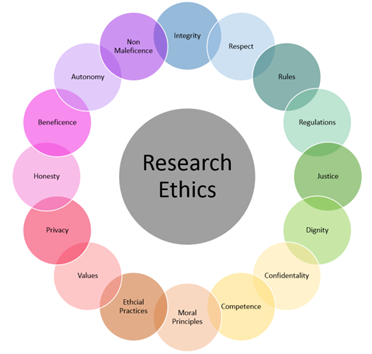
Figure 3.9: Research ethical principles
Moral principles of the study have not been breached at any as well. Before conducting the study, an ethical form was signed by the participants that strengthened the confidence level of participants. The Data Protection Act 2018 plays an important role in engaging the importance of data privacy and assuring proper safety measures to anyone’s confidential data (Phillips, 2021). Research information and private information of the participants have been protected with this Act that has safeguarded the study from any kind of misconduct. Ethical Code of Practices refers to the protection of participants' response abilities towards the study. Such safeguarding of the research ethics has increased the benefits by assuring that all the engaged persons are appropriately informed.
Chapter 4: Results and Findings
All the collected data by the survey process has been analyzed by using the SPSS software in order to understand the influence of workplace and employee motivation in organizational performance. Histogram analysis is an important tool that can be used in the study of the influence of the workplace environment and employee motivation on the performance of the organization at Unza Vitalis Salatiga. By analyzing the data from surveys and interviews with employees regarding their experience of their work environment and motivation, histogram analysis can provide a visual representation of how these elements influence performance. These results can be used to inform decisions around improving workplace conditions, motivating staff, and designing incentives to optimize performance. Histograms offer insight into how changes in the environment may affect employees’ motivations, performance and satisfaction. By studying the distribution of data in various groups, patterns can be identified which may indicate problems or areas that need attention (Badrianto and Ekhsan, 2019). Through histogram analysis, researchers can identify areas where improvements are needed for the organization, compare different departments or locations, and decide which strategies are most likely to result in better performance and higher levels of employee engagement.
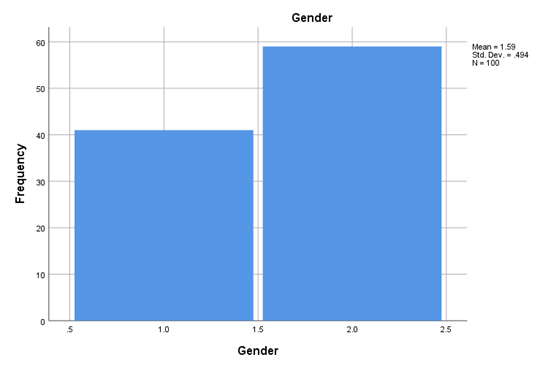
Figure 4.1: Histogram analysis of gender
The particular histogram analysis for the gender has been revealed that the frequency of male participants from the organization Unza Vitalis Salatiga has been less than the frequency of the female participants in the particular research.
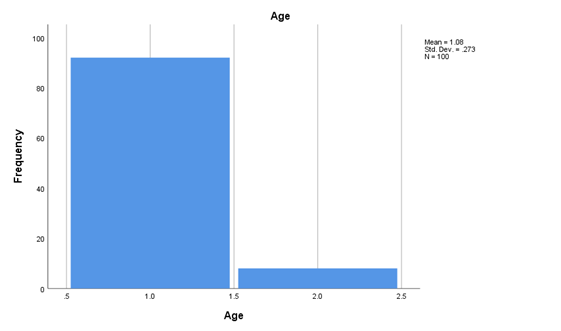
Figure 4.2: Histogram analysis of age
As per the above histogram analysis has been evaluated that the maximum frequency of participants are below the age of 18 for the particular research regarding the influence of workplace culture and employee motivation on the organizational performance.
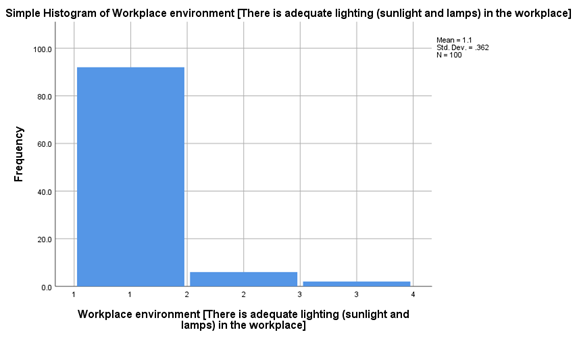
Figure 4.3: Histogram analysis of the responses
According to the above graph, the maximum frequency of the participants has been strongly agreed that the organization has adequate lighting including both the sunlight and lamps within the workplace. Small frequency of participants has agreed with the statement and very less frequency of participants has remained neutral that is neither agree nor disagree with the statement. No one of the participants has disagreed or strongly disagreed with the statement.
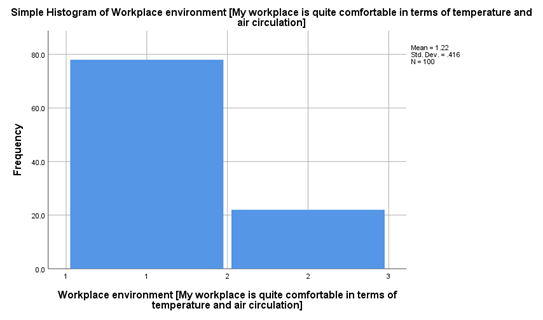
Figure 4.4: Histogram analysis of the response
The particular graphical representation shows that the maximum frequency of the participants has been strongly agreed and less number of participants has been agreed with the statement that the workplace has comfortable temperature and air circulation. None of the participants has disagreed or strongly disagreed.
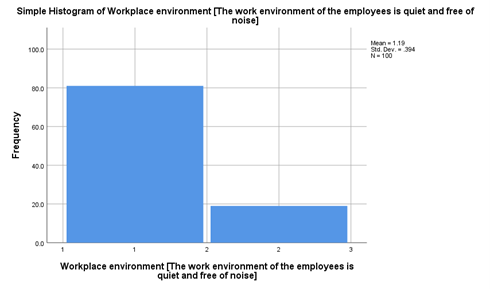
Figure 4.5: Histogram analysis of the response
The graphical representation indicates that the majority of participants have strongly agreed that the workplace is free of noise. A smaller number of participants have agreed with this statement. No one has disagreed or strongly disagreed. This suggests that the majority of people are content with the noise free environment in their workplace.
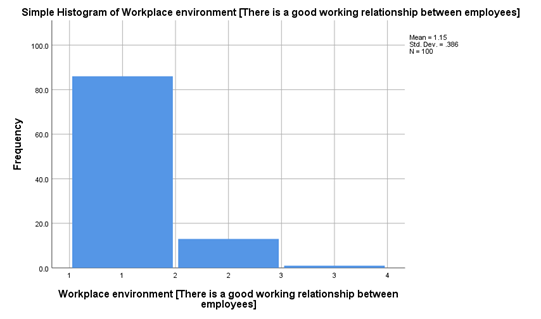
Figure 4.6: Histogram analysis of the response
The data in the graph reveals that the majority of the participants surveyed expressed high agreement that the organization has good relationships among their employees. Few participants expressed agreement while very less number of participants expressed neither agree nor disagree. This indicates a significant number of people found the employee relationship is good, with no one disagreeing with the statement at the current conditions.
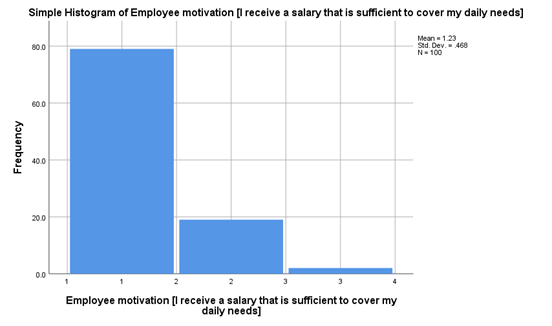
Figure 4.7: Histogram analysis of the response
The graph is based on the survey regarding the satisfaction of the employees of the organization with their current salaries. The histogram analysis has been revealed that the highest number of participants has been strongly agreed with the statement that reflects that they are satisfied with their salary for their daily needs. Small frequency of the response from the participants is “Agreed” for the particular statement. Very few participants have remained neutral that is neither agree nor disagree with the statement regarding their satisfaction with the salary in order to cover up their daily needs.
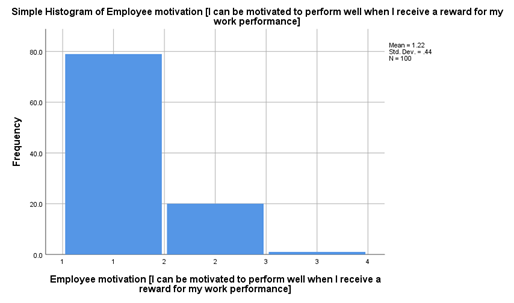
Figure 4.8: Histogram analysis of the response
Regarding the employee motivation, the above histogram graph represents the frequency of the responses regarding the statement that the employee can be motivated to perform their work with high efficiency if they received reward for their performance. Most of the participants strongly agreed, a small number of participants agreed and a very less number of participants neither agree nor disagree with the statement. No one of the participants has disagreed with the statement.
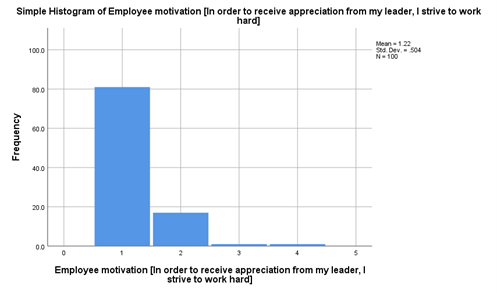
Figure 4.9: Histogram analysis of the response
The survey regarding the received appreciation from the team leader for their hard work in the organizational performance has been presented in the form of a graph. The histogram analysis has revealed that the majority of participants strongly agreed with the statement, indicating that they used to work hard in order to receive the apparition from their team leaders. The frequency of "Agree" responses from the participants was comparatively low. Very few participants acted neutrally that neither agree nor disagree with the statement concerning their hard work to receive appreciation. Some people also disagreed with the statement but the frequency of this response is very minimal compared with other responses.
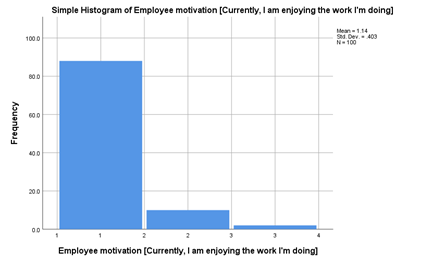
Figure 4.10: Histogram analysis of the response
As per the above graphical representation of the employee motivation, the highest number of participants has strongly agreed that they are currently enjoying their work in the organization. Small number of participants agreed with the statement and very few participants neither agree nor disagree with the statement that they are currently enjoying their work in the organization.
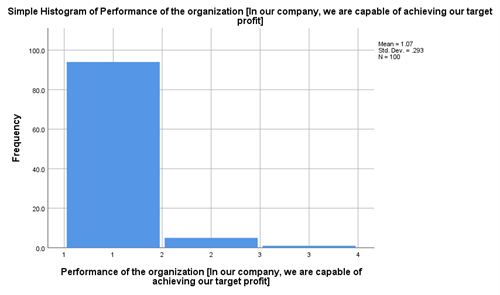
Figure 4.11: Histogram analysis of the response
The above graphical representation has been showing that the heist frequency of the participant response for the statement that they are capable of achieving their target profit in the particular organization is strongly agreed. Small number of participants has agreed with the statement and minimal number of participants has neither agree nor disagree with the statement. No one of the participants feels that they are not capable of achieving their target profit with their work within the organization.
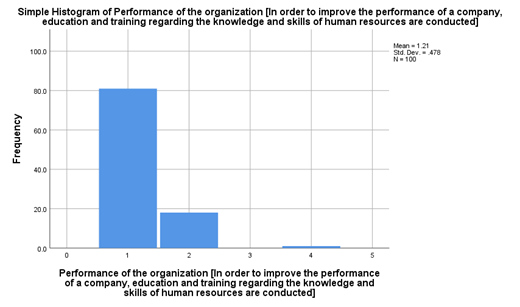
Figure 4.12: Histogram analysis of the response
Regarding the survey of the performance of the organization, the graph illustrates the reactions of participants to the statement that to improve the organizational performance the organization uses to provide education as well as training for developing employee skills and knowledge. Most people strongly agreed, with a small number agreeing with the particular statement.
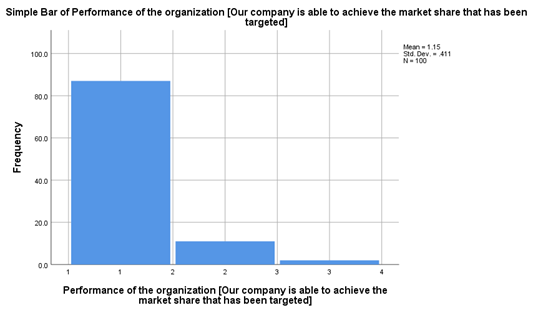
Figure 4.13: Histogram analysis of the response
The above histogram graph shows the responses to the statement that the company has been able to achieve the market share which has been targeted with the high efficiency of organizational performance. Most of the participants strongly agreed that the Unza Vitalis Salatiga Company has been able to achieve the targeted market share. Notably, a small number of participants agreed yet a very less number of people neither agree nor disagree. Remarkably, no one of the survey respondents disagreed with the statement.
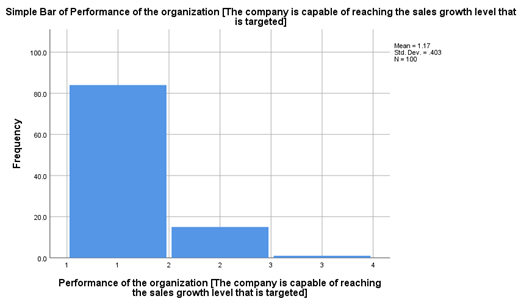
Figure 4.14: Histogram analysis of the response
The results of the histogram analysis above indicate a high frequency of strongly agreed response that claims that Unza Vitalis Salatiga is capable of reaching the sales growth level that has been targeted. Most participants strongly agreed with the opinion, while a small number agreed and an even smaller number said they neither agree nor disagree. It is remarkable that there was not a single respondent who disagreed with the statement.
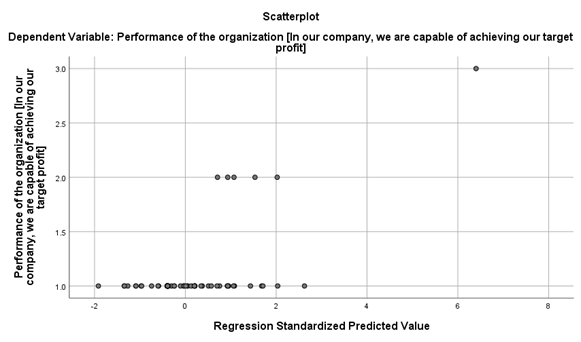
Figure 4.15: Scatterplot analysis
Overall significance level less than 0.05 implies that the independent variables have a strong statistical correlation with the dependent variable, meaning that any changes in the independent variables is likely to have a significant impact on the outcome of the dependent variable. This suggests that Unza Vitalis Salatiga company employees are competent and have the capability to achieve their target profits, which means they are able to produce positive results that maximize our profits. This can be achieved through proper utilization of skills and expertise, developing strategies and plans, and executing the necessary measures with steadiness and consistency (Bangun et al. 2019). In this case the null hypothesis that work environment and employee motivation do not influence the organizational performance at Unza Vitalis Salatiga has been rejected.
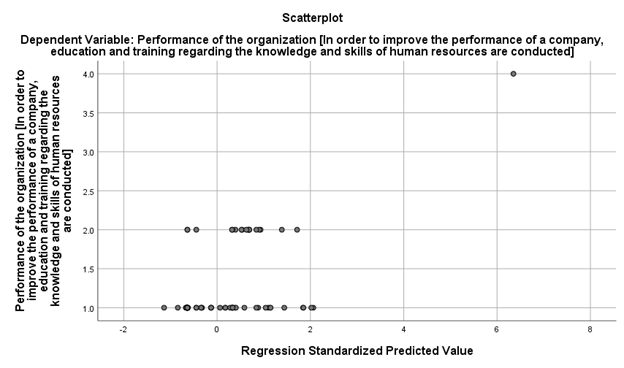
Figure 4.16: Scatterplot analysis
When the significance level of an independent variable is higher than 0.05, it means that the independent variable is not significantly associated with the dependent variable. This suggests that education and training related to the knowledge and skills of human resources may not be directly contributing to improved performance of a company. Further research may be required to determine if there is a link between these two variables (Al-Douri et al. 2020). In this case, the null hypothesis has been accepted and the alternative hypothesis has been rejected.
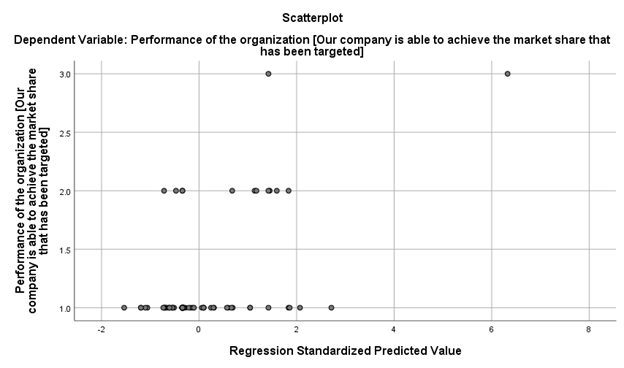
Figure 4.17: Scatterplot analysis
The significance level of other independent variables is higher than 0.05 means that these independent variables have no significant correlation with the dependent variable, which means that the company is unable to reach its targeted market share. As per the analysis the null hypothesis has been accepted and the alternative hypothesis has been rejected.
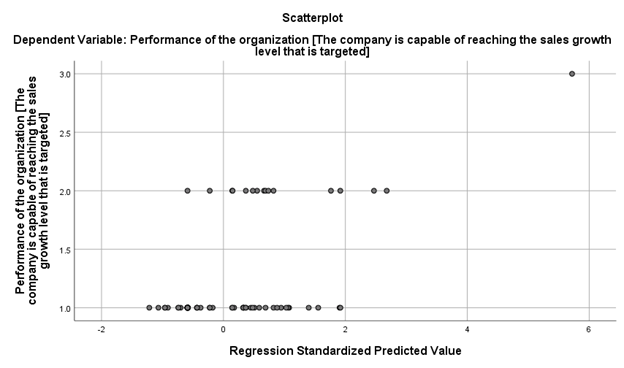
Figure 4.18: Scatterplot analysis
A significance level, greater than 0.05 indicates that the other independent variables are not significantly related to the dependent variable in regards to sales growth. This implies that there are other factors contributing to the sales growth level, such as marketing strategies, consumer behavior, economic conditions and industry-level competition. Therefore, in order for the company to meet its sales growth target, it will need to analyze the various factors that could potentially affect the sales growth and develop strategies to capitalize on these factors in order to achieve its desired results (Purwanto et al. 2021). In this case the null hypothesis has been accepted and the alternative hypothesis has been rejected.
Chapter 5: Discussion and Evaluation
It has been seen that the research has not been conducted with any biases as male and female both have been given an equal chance to provide their opinions regarding how employees can get motivated and result in their improved performance level. It can be stated from the evaluation that organizational performances do not get bounded with any age or gender biases as business operations around the world are seeking for equal engagement of population for gathering different experiences and different perspectives. The outcome of IBM SPSS has defined that this study has not biased any aspect. Employee motivation is a psychological concept where the mind should be relaxed and think creatively about overworking issues (Fang et al. 2019). In today’s business world, the competition is raising faster and hence, the need of adequate sunlight and plantation is important. It has been noted in many studies that a clumsy and cozy environment can hamper employees’ mental state and make them depressed that lowers down their creativity. The maximum of opinions have been gathered in favor of the adequate sunlight availability in the working environment for motivating employees and enhancing the stability of the work environment. Hence, it can be evaluated from the study that higher degree of agreeableness towards this variable has a direct connection towards organizational performance enhancement.
In addition to this, agreed votes have gone towards the employees’ perception where participants have said that availability of temperature and air circulation is making their working environment comfortable. Excessive heat or excessive cold weather can de-touch employees to get connected with the working requirements. Balancing in professional and personal lives is becoming a real-time hectic scenario for most of the employees due to hectic scheduled lifestyles (Denson et al. 2018). Natural states play a great role in influencing employees’ motivation that keeps them motivated for a longer term and makes them feel valuable for organizational growth. Among all the motivational factors of employees, temperature and air circulation must be accurate. Today’s township world cannot think anything else against air conditioners from their integration in the working places. None of the participants has been found to disagree with this question and have been found with majorly strongly agreed opinions in regards. Improper temperature and heat in the working environment can impact employee performances as well. Therefore, it can be evaluated that the study is concerned with motivating employees with a proper work environment by focusing on its environmental measures such as temperature, air circulation and lighting.
Apart from the above-mentioned natural elements to impact the working environment, noise is another vital concept that can hamper employee engagement with the organization. A high loud environment cannot allow employees to understand project requirements and concentrate on their work. For critical thinking ability, the working environment must be adequate with sceneries and calm where thinking differently with creative perspective can become easier. Positioning oneself with competitiveness in today’s competitive era, creative thinking is considered the most prior element to be entertained. Hard work always pays off and creative work can help in growing faster and get promoted faster in comparison to others (Ismail et al. 2019). Mostly positive opinions have strengthened this perspective and helped the Researcher in analyzing the impact of intangible work environment measures for enhancing organizational performance through critical employee engagement. Besides, studies have revealed that company operations het improved through the motivational efforts of employees. Employees in this context are asked to merge an individual's personal abtinition with others for achieving organizational goals. The soothing relationship between the workers helps them in understanding and identifying their different perceptions based on which they are contributing themselves towards the business success journey.
Lack of emotional bond with the coworkers make them less motivated towards work as situations get difficult with the passing time and they find themselves less valuable for the company. Every individual has their different types of motivational drivers that make their professional journey better and help them in achieving efficient success measures. Different employee motivational drivers are there such as affiliation, achievement, power and competence. As per Gaidhani et al. (2019), motivation is a general term for defining employees’ desire, wishes, needs and other similar forces. It is accused that employee motivation is a psychological process that affects an individual’s behavior and directions towards the business goal and achievement. All the 100 participants have answered to these questions and shown their larger opinions towards the strongly agree by clarifying inner-striving conditions. Employee to employee relationship is found beneficial in manifesting the intentional behavior by predicting their behavioral patterns. The unsatisfied need in such a work environment can affect organizational productivity negatively.
Rather than fulfilling the dreams or career destination, most of the people are found to keep them motivated with the working measures for attracting a good salary. HRM practices focus on the employee performance and their dedication level towards a performance based on which the promotional or incremental decisions get made. Money is an all time true influencer for an employee that encounters the motivational attributes with greater potentialities of intrinsic factors (Ali and Anwar, 2021). HRM leaders must think about the employees’ performance level to decide an appropriate wage pattern for motivating employees. Contribution of employees must not be neglected as it might bring dissatisfaction among the employee group and performance efficiency can go down. The analysis of the statistical presentation has clearly mentioned that fundamental labor wages must be increased over the time based on their valuable performances. Rewards, promotion and salary increment are some major factors that any individual seeks for while positioning in a firm for a longer time or seeking for better options in this high-end competitive market. This empirical evidence of this is therefore found effective in understanding the freshness of the chosen topic in enhancing the performance level of UNZA VITALIS SALATIGA. Employees opined that the mentioned organization pays off them with the accurate and appropriate terms of today’s labor wages standard that are good enough to cover their daily essentials. Hence, it can be stated that the chosen organization is valuing its employees in the proper way and employees are happy with their monetary commitments.
An organization that fulfills the basic need of an employee and tries hard to keep them motivated from different aspects, employees also contribute their dedication and efficiency performance towards the access of the business by bringing goodwill in the global business platform. In this case, the same has also been done where employees are found happier with the organizational policies as the organization is making the work environment efficient from most of the basic needs. Reward system is also available in the company that is making employees motivated and increasing their performance level in regards to organizational growth. Reward system must be of two types- monetary and nonmonetary to praise the contribution of employees (Tumi et al. 2022). A significant amount of monetary reward can help in satisfying the employee's soul against its contribution. For non-monetary rewards, organizations can serve employees with a flexible work environment by allowing them to have an extra leave and volunteering their work responsibly. Small gifts or vouchers every month by arranging a performance based reward system can also influence employees to position themselves with strong self-esteem.
The employees have also said that for increasing the performance, the organization conducts training and education programs by which sharing knowledge as well as sharing business goals with different objectives has become possible. Employees are entering their workplace environment. Human resource management is helping employees in increasing their knowledge and skills that is helping in achieving the project targets in both short and long term patterns. Knowledge transfer process in any organization is helpful for spreading motivation among employees. For such transferable skills towards employee motivation what is mostly needed is a good mentorship, guidance and community of practices (Sun et al. 2020). In collaboration with the coworkers, integrating innovation and indenting business goals have become possible that has increased the performance level of UNZA VITALIS SALATIGA.
After defining the organization’s contribution towards employees’ motivation, it is the time to evaluate their after effects as a result of organizational success. Employees have shared their opinions by agreeing with the statement that their motivation factor and dedicated work has made the organization able to take part in a larger market share. Besides, the firm has been able to increase its sales growth measures. For ensuring better organizational profitability, employees must give their hundred per cent to the project ambitions that are dependent on their motivational level. The overall analysis of the dataset has been found stable to prove the true sense of the hypotheses by testing its reliability and validity measures. Hence, the alternative hypothesis has been proved true in sense for complementing the research topic in a concise manner. All the discussion has shown how clearly one variable is dependent on another one, beyond the dependent and independent characteristic. The organization has a higher chance to enhance its business process with the efficiency measures. Hence, evaluation has directed towards the improvement of organizational performances through improvement of work environment and employee motivation level.
Discussing organizational growth, employee motivation plays a vital role for enhancing the stability. It has been seen that a well-motivated employee can produce huge productivity in the business area for creating sustainability. On the other hand, evaluation of the strategies in the sector can also change the working stage better for maintaining a better work process. Working environment is another crucial part in the area that improves the business performance and stability to achieve the ultimate goal (Groysberg et al. 2018). Creating a proper working environment will also maximize the stability and evaluation of the performance to derive the business process among the competitors.
Impact of the workplace environment can also ensure the performance is successful to maintain stability among the competitors in the market. The stable positioning and strategic implementation also increases the business growth and enhancement of the stability (Hoffmann et al. 2018). In the achievement of the business goal and objective, the factor is also important to improve the business performance in the working market. Unza Vitalis Salatiga also holds the proper working environment that increases the organizational goal. The sustainable working environment will also create a better progress of the work in the market for maintaining a better value. In the personal care business market, the business structure will be helpful for maximizing the growth.
Huge profitability can be found by keeping the employee motivation properly in the business area. This also increases the sustainability in the market to keep the proper track of the business performance. Work life quality is another factor in the area that enables a better value of the work in the particular business area. This enables a better value and creation of the progress in the target area. Therefore, maintaining the employee motivational factors effectively will improve the business structure and development of the strategy in the area. Decreasing the error margin in the business area keeps the work process better to enhance the performance in the particular business trade. Unza Vitalis Salatiga maintains the factor to improve the work life proper in the business area. Focusing on employee satisfaction, remuneration and other factors need to be managed by the business unit to increase the performance better in the competitive market (Martono et al. 2018). Strategic implementation might also be a helpful option for maintaining the process better to create the performance measures.
Recognition is another part that improves the working activity better to create the working process successful in the market. The significant changes in the area will also evaluate the structure successful for implementing the motivation at a higher level. In this particular research study, a primary qualitative process has been adopted to evaluate the entire knowledge properly. Along with this, non-probability sampling and primary data collection procedure has also been adopted to perform the analysis properly. Discussing the tools, IBM SPSS has been adopted by the researcher to perform the data analysis for making suitable decisions. In the end, it has been found that the impact of the working environment and employee motivation has a positive impact on organizational performance.
Chapter 6: Conclusion and Recommendations
6.1 Conclusion
From the overall analysis, it can be concluded that strategic moves must be taken by the organization in terms of increasing employees’ motivation level. Quality of work life is dependent on the work environment that can decrease the dissatisfaction level of employees during a hectic busy schedule. Absenteeism of the employees indicates that the leaders of the organization are not concerned while employees’ agreed responses have proved that the selected organization is focused about increasing their motivational level and increasing their dedication. Job enrichment and merit pay can engage employees with a stronger relationship with the firm.
The defined variables in this study has been entertained with due priority in every part where from as literature section has proved the alternative hypothesis is true in sense, taking into account such opinions of authors and participants, it has been concluded that work environment must be optimized in a regular manner to find out the flaws an employees’ demands from their operating business platform. This research paper has analyzed that financial motivation is equally important in accordance to the participants' opinions that can increase sales and position in market share. Analysis has also revealed that the work environment must also be effective for increasing employee motivation by keeping temperature, air circulation, light and others with proper lead. Leadership has also been concluded with its importance towards sharing real-time knowledge and project aims for achieving business success.
6.2 Linking with objectives
-
To investigate the effect of workplace environment on the performance of the organization
As per the analysis, the researchers have discovered that the maximum number of participants have strongly agreed with the effect of work[place on the performance of the organization. The workplace environment of any organization can have a substantial influence on the performance of its employees. A pleasant work environment can help employees be more productive, while an unhealthy and stressful atmosphere can hinder their ability to perform at their best. In the case of Unza Vitalis Salatiga company, the workplace environment has a direct effect on the performance of the organization in terms of employee morale, productivity, creativity, and innovation. When workers are exposed to a positive work environment, it creates a sense of motivation and engagement that leads to higher levels of productivity. When employees are happy in their job and feel supported by senior management, they become more committed and willing to put in extra effort and take on challenging tasks. This encourages greater collaboration between team members as well as with other departments within the company, ultimately leading to better performance. On the other hand, if the workplace is characterized by stress or excessive negativity this often results in a drop in morale, which negatively affects performance. This can include conflicts between workers due to poor communication practices, inadequate resources for completing tasks or roles that do not personal interests and development.
-
To examine the effect of employee motivation on the organizational performance of the organization
Employee motivation can significantly contribute to the overall performance of an organization. It can provide employees with a sense of purpose, direction and enthusiasms towards their work, enabling them to stay focused and keep striving for excellence. At Unza Vitalis Salatiga, employee motivation manifests in many different aspects such as; providing meaningful work with sufficient opportunities for learning and development, fair compensation, appreciation and recognition for outstanding work, transparent communication and feedback from managers, as well as involvement in team goals. A motivated workforce drives performance since each individual employee is dedicated to achieving company goals. As a result of providing meaningful work, employees of Unza Vitalis Salatiga are likely to be more engaged with their tasks, leading to a higher quality of output due to improved attention to detail. Furthermore, when employees feel appreciated for their hard work which is often the result of recognition initiatives or reward schemes implemented by the organization, their morale increases resulting in increased motivation which in turn can be translated into improved sales or customer satisfaction. Providing encouraging workplace environments provides an environment that allows creative ideas and collaboration among employees as they can share their thoughts openly with management and colleagues. This environment encourages innovation while eliminating fear of failure as employees are allowed to take risks in order to come up with other possibilities that can further improve organizational performance. Additionally, transparent communication between employer and employees leads to trust which when accompanied by loyalty helps improve organizational performance since employees focus on achieving company objectives rather than their own interests.
-
To determine whether the relationship between employee motivation and the work environment is related to the organization's performance at Unza Vitalis Salatiga company
The relationship between motivating employees and the work environment to organization performance is integral to the success of any company. Studies have found that a positive and stimulating work environment, combined with adequate incentive and motivation boost employee satisfaction, productivity, loyalty, and performance. At Unza Vitalis Salatiga Company, researchers believe in creating a work environment that is conducive to both employee motivation and performance. A comfortable and stress-free atmosphere combined with flexible work policies encourages employees to bring out their best potential capability in the workplace. The research has been analyzed that positive work environments have positive effects on employee’s job satisfaction. Positive reinforcement of achievements by providing incentives and rewards highly motivate employees to perform better while creating healthy competition amongst them. This also encourages collaboration and team building within the workplace. A positive work environment also fosters employee motivation in several ways. A supportive working culture, where employees feel like they belong and are valued, increases satisfaction and loyalty. This can be achieved through regularly engaging with employees, taking their feedback seriously, providing them with more resources or tools for inspired work, and creating a pleasant working atmosphere. When employees feel supported in their tasks and develop a sense of trust with their manager, it leads to improved collaboration, commitment and cooperation within the team. Enhanced employee motivation coupled with a positive work environment inevitably produces better organization performance. High-performing teams tend to achieve more outcomes as they split tasks among themselves, assign ownership and take their initiatives seriously. Unza Vitalis Salatiga has excelled in this, indicating the strong connection between employee motivation and the working environment on organizational performance.
6.3 Research Limitation
Primary data analysis process has been followed during the research to understand the influence of the particular workplace environment along with employee motivation in the organization Unza Vitalis Salatiga. However, the research comes with certain limitations. Firstly, time constraints can restrict the amount and quality of data that need to be collected. The time needed to conduct focus groups, interviews and surveys necessary for data collection is predefined before the data is gathered. As a result, there may be some important information which may not be captured. Secondly, there may also be potential ethical issues involved in primary research as Unza Vitalis Salatiga has to get approval from the relevant stakeholders before collecting data about its employees or customers. There is also a risk of breaching confidentiality which might lead to inaccurate or unreliable results. There is also a risk that biased or untrustworthy data collected from respondents may affect the accuracy of the research results. Since surveys rely largely on self-reported information from respondents which may not always result in honest and reliable outcomes due to respondents’ personal opinion towards certain topics or lack of understanding and knowledge about them. Any bias from the researcher during the process can impact the accuracy of results from primary research as those employed by Unza Vitalis Salatiga will likely hold a specific agenda in data collection and analysis. This causes deviation from objectivity which in turn affects veracity and generalizability of data gathered through this process. On the other hand, quantitative analysis restricts the concrete analysis of the factual data regarding the types of motivation and workplace culture that are suitable for influencing the performance of the employees.
6.4 Recommendation
In order to collect more possible data it is important that efforts should be made to collect more data from other secondary sources. Rather than focussing on primary data collection methods such as questionnaire surveys, interviews, and field visits to obtain information on workplace environment and employee motivation, secondary data collection methods can also be implemented in order to obtain information from multiple sources like internet websites, articles and journals, reports, etcetera (HARYONO and SULISTYO, 2020). This would enable researchers to triangulate the findings with both qualitative and quantitative tools so that appropriate results could be obtained. It is important to analyze both the qualitative as well as quantitative data during the research to analyze appropriate results regarding the topic. In order to analyze the data in a statistical format the researchers must be aware and skilled in operating statistical tools and practices (Al-Musadieq et al. 2018). Furthermore, to reduce the biases in the result, it is important to collect a large amount of data that will also help the researchers to evaluate more appropriate results regarding the particular research.
6.5 Future Scope
Further research should be conducted to gain a more comprehensive understanding of how changes to the workplace environment affect staff motivation and performance at Unza Vitalis Salatiga. Continuous evaluation can help ensure a positive ecosystem that encourages employees to contribute optimally to growth and organizational success. Furthermore, it is also suggested to research how external factors such as global forces, technology advancements, shifts in consumer needs and preferences are impacting work practices at Unza Vitalis Salatiga. Additionally, an examination of the effect of changes in organizational structure on individual attitudes towards their job may help to gain insights into how transformation strategies are impacting performance. In addition to these investigatory areas, survey-based studies may help to capture broader perspectives from a larger target audience. Further surveys can be carried out focusing on leadership styles and their impacts on staff motivation and productivity. Moreover, focus-based interviews with key members within the organization may provide valuable information about existing processes that have become outdated in addressing modern work environment challenges. These findings can then be used to improve existing systems or create new ones to foster collaboration among all stakeholders.
Reference list
Akoglu, H., 2018. User's guide to correlation coefficients. Turkish journal of emergency medicine, 18(3), pp.91-93.
Al-Douri, J.A., Aldabbagh, I., Mohammad, M.M. and Qawasmeh, R., 2020. The impact of Islamic work ethics on job performance with mediating role of intrinsic motivation. Academy of Strategic Management Journal, 19(2), pp.1-11.
Ali, B.J. and Anwar, G., 2021. An empirical study of employees’ motivation and its influence job satisfaction. Ali, BJ, & Anwar, G.(2021). An Empirical Study of Employees’ Motivation and its Influence Job Satisfaction. International Journal of Engineering, Business and Management, 5(2), pp.21-30.
Al-Musadieq, M., Nurjannah, N., Raharjo, K., Solimun, S. and Fernandes, A.A.R., 2018. The mediating effect of work motivation on the influence of job design and organizational culture against HR performance. Journal of Management Development.
Badrianto, Y. and Ekhsan, M., 2019. The effect of work environment and motivation on employee performance of pt. Hasta multi sejahtera cikarang. Journal of Research in Business, Economics, and Education, 1(1).
Bangun, R., Ratnasari, S.L. and Hakim, L., 2019. The influence of leadership, organization behavior, compensation, and work discipline on employee performance in non-production departments PT. Team Metal Indonesia. Journal of Research in Psychology, 1(4), pp.13-17.
Denson, N., Szelényi, K. and Bresonis, K., 2018. Correlates of work-life balance for faculty across racial/ethnic groups. Research in Higher Education, 59(2), pp.226-247.
Fang, Y.C., Chen, J.Y., Wang, M.J. and Chen, C.Y., 2019. The impact of inclusive leadership on employees’ innovative behaviors: the mediation of psychological capital. Frontiers in psychology, 10, p.1803.
Gaidhani, S., Arora, L. and Sharma, B.K., 2019. Understanding the attitude of generation Z towards workplace. International Journal of Management, Technology and Engineering, 9(1), pp.2804-2812.
Groysberg, B., Lee, J., Price, J. and Cheng, J., 2018. The leader’s guide to corporate culture. Harvard business review, 96(1), pp.44-52.
HARYONO, S. and SULISTYO, B.A., 2020. Effects of work motivation and leadership toward work satisfaction and employee performance: Evidence from Indonesia. The Journal of Asian Finance, Economics and Business, 7(6), pp.387-397.
Hoffmann, W., Lavie, D., Reuer, J.J. and Shipilov, A., 2018. The interplay of competition and cooperation. Strategic Management Journal, 39(12), pp.3033-3052.
Ismail, H.N., Iqbal, A. and Nasr, L., 2019. Employee engagement and job performance in Lebanon: the mediating role of creativity. International Journal of Productivity and Performance Management, 68(3), pp.506-523.
Kuswati, Y., 2020. The effect of motivation on employee performance. Budapest International Research and Critics Institute (BIRCI-Journal): Humanities and Social Sciences, 3(2), pp.995-1002.
Martono, S., Khoiruddin, M. and Wulansari, N.A., 2018. Remuneration reward management system as a driven factor of employee performance. International Journal of Business & Society, 19.
Mellinger, C.D. and Hanson, T.A., 2020. Methodological considerations for survey research: Validity, reliability, and quantitative analysis. Linguistica Antverpiensia, New Series–Themes in Translation Studies, 19.
Paais, M. and Pattiruhu, J.R., 2020. Effect of motivation, leadership, and organizational culture on satisfaction and employee performance. The Journal of Asian Finance, Economics and Business, 7(8), pp.577-588.
Pandey, J., 2019. Deductive approach to content analysis. In Qualitative techniques for workplace data analysis (pp. 145-169). IGI Global.
Pathiranage, Y.L., Jayatilake, L.V. and Abeysekera, R., 2020. Case study research design for exploration of organizational culture towards corporate performance. Review of International Comparative Management/Revista de Management Comparat International, 21(3), pp.361-372.
Phillips, B., 2021. UK further education sector journey to compliance with the general data protection regulation and the data protection act 2018. Computer Law & Security Review, 42, p.105586.
Pietilä, A.M., Nurmi, S.M., Halkoaho, A. and Kyngäs, H., 2020. Qualitative research: Ethical considerations. In The application of content analysis in nursing science research (pp. 49-69). Springer, Cham.
Prayetno, S. and Ali, H., 2020. The influence of work motivation, entrepreneurship knowledge and advocate independence on advocate performance. International Journal of Innovation, Creativity and Change, 150.
Purwanto, A., Asbari, M., Santoso, T.I., Sunarsi, D. and Ilham, D., 2021. Education Research Quantitative Analysis for Little Respondents: Comparing of Lisrel, Tetrad, GSCA, Amos, SmartPLS, WarpPLS, and SPSS. Jurnal Studi Guru Dan Pembelajaran, 4(2).
Robertson, A. and Sibley, C.G., 2018. Research sampling: a pragmatic approach. Advanced Research Methods for Applied Psychology, pp.15-36.
Roth, W.M. and Von Unger, H., 2018, September. Current perspectives on research ethics in qualitative research. In Forum qualitative sozialforschung/forum: Qualitative social research (Vol. 19, No. 3, pp. 1-12). DEU.
Runco, M.A. and Beghetto, R.A., 2019. Primary and secondary creativity. Current Opinion in Behavioral Sciences, 27, pp.7-10.
Shkoler, O., 2018. Using contemporary quantitative techniques. In Quantitative Research Methods in Consumer Psychology (pp. 22-58). Routledge.
Sun, Y., Wang, C. and Jeyaraj, A., 2020. Enterprise social media affordances as enablers of knowledge transfer and creative performance: An empirical study. Telematics and Informatics, 51, p.101402.
Sürücü, L. and MASLAKÇI, A., 2020. Validity and reliability in quantitative research. Business & Management Studies: An International Journal, 8(3), pp.2694-2726.
Tumi, N.S., Hasan, A.N. and Khalid, J., 2022. Impact of compensation, job enrichment and enlargement, and training on employee motivation. Business Perspectives and Research, 10(1), pp.121-139.
Woiceshyn, J. and Daellenbach, U., 2018. Evaluating inductive vs deductive research in management studies: Implications for authors, editors, and reviewers. Qualitative research in organizations and management: An International Journal, 13(2), pp.183-195.
Žukauskas, P., Vveinhardt, J. and Andriukaitienė, R., 2018. Philosophy and paradigm of scientific research. Management culture and corporate social responsibility, 121.



